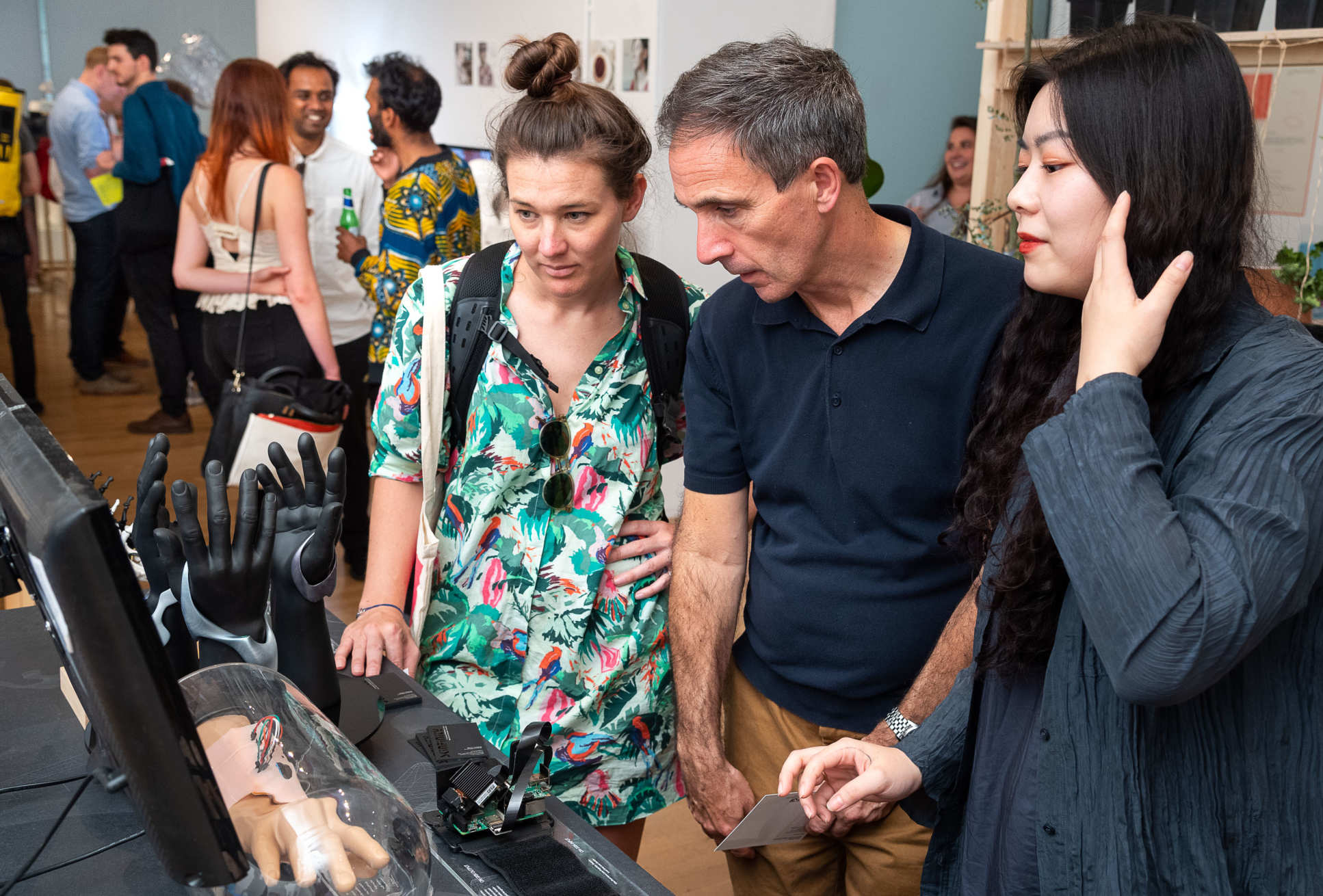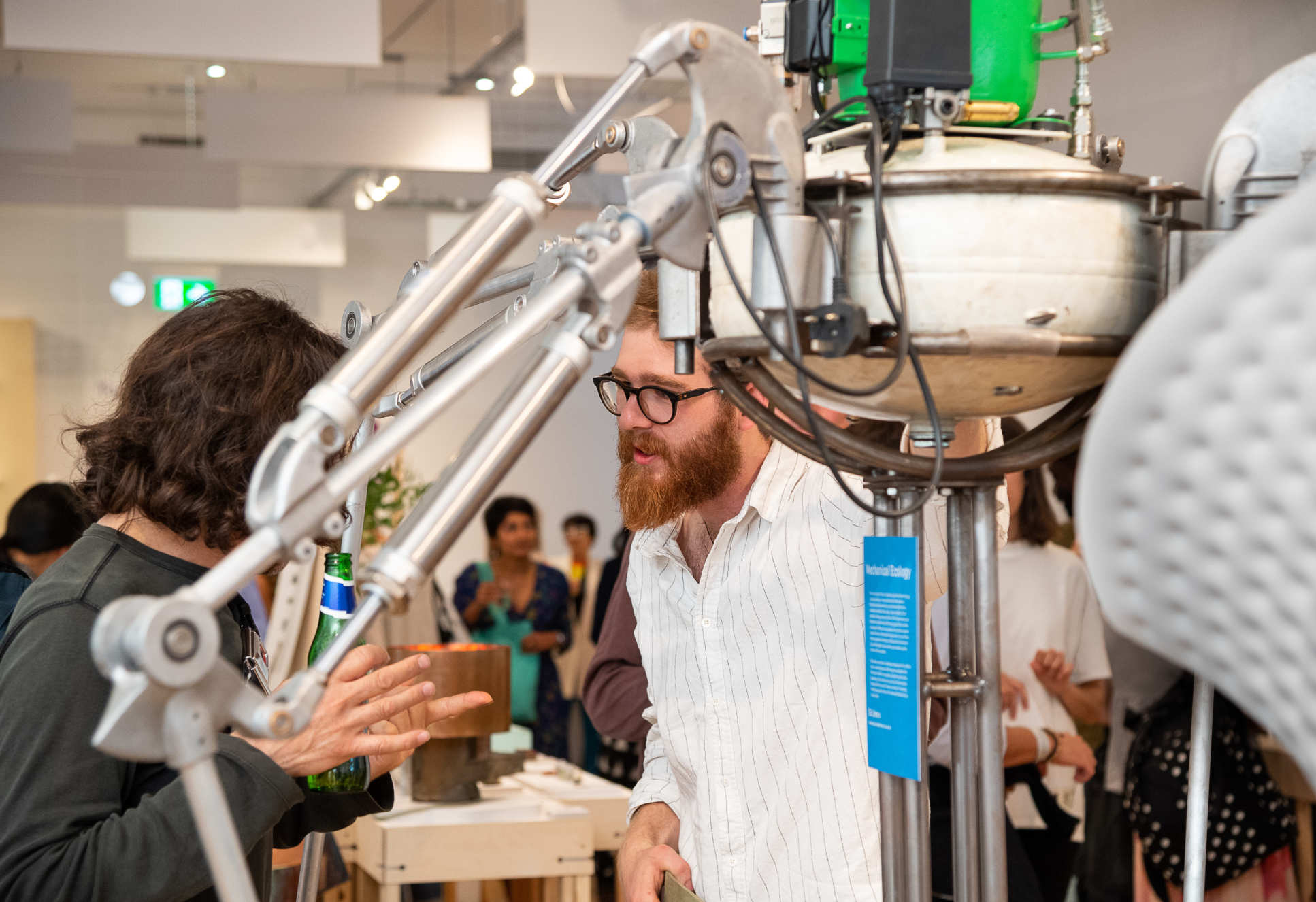
Photo credit (all images): Stephen Pover //Royal College of Art

Design Engineering students are giving a glimpse into the future of technology and design in their end of year showcase.
The postgraduate exhibition, held this week at the Royal College of Art, features more than fifty examples of innovative design, revolutionary technology, and game-changing ideas from students enrolled on either Innovation Design Engineering (IDE) or Global Innovation Design (GID) programmes – which are delivered jointly by Imperial's Dyson School of Design Engineering and the Royal College of Art.
From programmable hair dye that can be changed in an instant, to technology that would allow our skin to be used as an interactive interface, their projects offer provocative insights into the products of tomorrow.

Biodegradable fun

Fernanda Dobal, a Global Innovation Design student, has developed a biodegradable toy to help teach children about the carbon cycle.
The pack comes with a biodegradable woolly mammoth toy, a packet of seeds, and an augmented reality app. After they have finished playing with it, children can bury the mammoth with the seeds, and visualise the processes happening underground through the app as the plant grows. Once the outer material has biodegraded, the app alerts them and they can act like paleontologists as they excavate the toy’s ‘skeleton’.
Medical technologies
Many students on the Innovation Design Engineering course used their design talents to tackle key healthcare challenges.
This includes Lucy Jung, who has developed a wearable device to help reduce the symptoms of Parkinson’s disease. The device delivers vibrations to the sternum, and in initial testing participants reported that it allows them to have easier, faster and smoother movements.
Amir Afshar has created a garment that can function as a walking aid to support knee injuries using muscle sensing technology, while fellow student Sydney Chester has developed adaptable and customisable clothing that can provide spinal support to people with osteoarthritis.
Underwater communication
Keren Zhang, an Innovation Design Engineering Student, has developed a new, light-based underwater communication system for divers.
Lumio uses ‘Li-Fi’ – a wireless communication technology which utilizes light to transmit data between devices. The device would allow divers to speak to each other underwater in real-time, rather than relying on hand signals. Through the technology, Keren aims to improve the safety of diving and enable new underwater interactions.

New materials from waste
Many of the students are exploring innovative new uses for waste materials and by-products.
Andrew Edwards, who studied Innovation Design Engineering, has developed a technique to turn waste brine from seawater desalination into synthetic stone.

Making seawater drinkable is a potential solution to diminishing freshwater supplies, but the desalination process produces brine as a by-product. Currently, the brine is disposed of in the ocean, but it can harm fragile marine ecosystems.
Andrew’s project demonstrates a way that new products could be made from brine, creating a mouldable synthetic stone made into a series of objects.
Kevin Rouff also demonstrated how he is taking an industrial waste material and turning into functional objects.
He uses red mud, otherwise known as bauxite residue, a toxic by-product of refining bauxite ore into alumina, and transforming it into a range of vibrant pottery, ceramics and glazes.

Design Engineering at the Great Exhibition Road Festival
During the Great Exhibition Road Festival 2019, held on 29 and 30 June, the Dyson School of Design Engineering opened its doors to the public to highlight some of the most exciting research and innovation emerging from the School’s students and academics.
This included final year work from the School’s undergraduate students. Ideas ranged from software that could provide echolocation training for people with visual impairment, living art that could clean the air in homes, and a flight simulation game which aims to tackle the fear of flying.
Researchers from the School also gave insights into the latest advances in the field. This included next-generation robotics, new battery technologies, and healthcare innovations.
- Photo credit (all images): Stephen Pover //Royal College of Art
Article text (excluding photos or graphics) © Imperial College London.
Photos and graphics subject to third party copyright used with permission or © Imperial College London.
Reporter

Deborah Evanson
Communications Division

Contact details
Tel: +44 (0)20 7594 3921
Email: d.evanson@imperial.ac.uk
Show all stories by this author



Leave a comment
Your comment may be published, displaying your name as you provide it, unless you request otherwise. Your contact details will never be published.